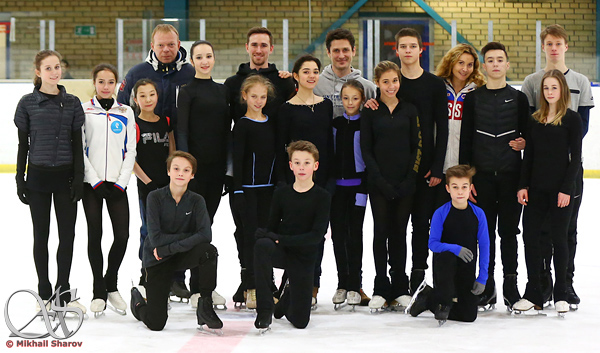Daniil Gleykhengauz: "Your athletes should be certain that you're their rock"
February 11, 2018
By Reut Golinsky
Photo © Reut Golinsky, Mikhail Sharov
 Daniil Gleykhengauz started skating when he was four years old, by chance. His mother, a ballerina who once performed in the Bolshoi, wanted him to study ballet, but he was still too young for that, so they chose figure skating. By the time he was seven he was already doing too well for his level to drop everything and switch. He changed a few coaches, worked with Viktor Kudriavtsev, finished third at Russian Nationals, qualified for junior Worlds in 2007, but there, during the practice he was injured. He had surgery with six month's recovery time but nothing helped; when he was forcing his training on the ice the pain returned. With month on, month off it was clear pretty quickly that triple Axels or quads would be out of the question. Eventually at the age of 18 he decided to try ice dancing. He started skating in Alexander Zhulin's group with Ksenia Korobkova. In the season of 2011/12 they won two of their first international competitions, the Pavel Roman Memorial and the NRW Trophy, but finished only 11th at the Russian Nationals. This result was really discouraging; he understood that there was still a very long road ahead. Around this time a tragedy happened, his father died, and he had to start providing for his family. He retired, started coaching, and skated in Ilia Averbukh's shows, moving from participation in group numbers to small solo performances. Around October 2014 Ilia told him that in Eteri Tutberidze's group they were looking for a skating skills coach, and since then he has been there, putting in a lot of work and dedication and gradually becoming a prominent part of her team. Now he is a full time coach and choreographer, a household name and quite a few of his programs were presented this season by top contenders among juniors and seniors. Five of them will be shown at the Olympic Games in PyeongChang.
Daniil Gleykhengauz started skating when he was four years old, by chance. His mother, a ballerina who once performed in the Bolshoi, wanted him to study ballet, but he was still too young for that, so they chose figure skating. By the time he was seven he was already doing too well for his level to drop everything and switch. He changed a few coaches, worked with Viktor Kudriavtsev, finished third at Russian Nationals, qualified for junior Worlds in 2007, but there, during the practice he was injured. He had surgery with six month's recovery time but nothing helped; when he was forcing his training on the ice the pain returned. With month on, month off it was clear pretty quickly that triple Axels or quads would be out of the question. Eventually at the age of 18 he decided to try ice dancing. He started skating in Alexander Zhulin's group with Ksenia Korobkova. In the season of 2011/12 they won two of their first international competitions, the Pavel Roman Memorial and the NRW Trophy, but finished only 11th at the Russian Nationals. This result was really discouraging; he understood that there was still a very long road ahead. Around this time a tragedy happened, his father died, and he had to start providing for his family. He retired, started coaching, and skated in Ilia Averbukh's shows, moving from participation in group numbers to small solo performances. Around October 2014 Ilia told him that in Eteri Tutberidze's group they were looking for a skating skills coach, and since then he has been there, putting in a lot of work and dedication and gradually becoming a prominent part of her team. Now he is a full time coach and choreographer, a household name and quite a few of his programs were presented this season by top contenders among juniors and seniors. Five of them will be shown at the Olympic Games in PyeongChang.
Daniil was very busy during the whole European championships, even during the gala practice he had four students to look after. I'm grateful that in the end he found time for this talk which brought a lot of interesting details about how he works and how their team functions.
 I want to start our talk from that moment four years ago when Ilia Averbukh proposed that you should work in Eteri's group.
I want to start our talk from that moment four years ago when Ilia Averbukh proposed that you should work in Eteri's group.
To be more precise, he proposed that Eteri invite me, gave her my phone number, and it was her initiative to call me and invite me to try out. It feels like yesterday, but it was almost four years ago.
Now you've finished your first Olympic cycle and during this cycle you've accomplished so much! You have five programs being skated during the Games; among them two have good chances of bringing medals.
I hope, we'll see.
When you were working on those programs did you feel an additional responsibility?
Yes, of course, you have no room for error. That's why our approach was really scrupulous. We had to understand what would suit each skater, which idea would help him/her, which character would be better, and to make everything comfortable. Some ideas I had for a very long time already, for example, Alina Zagitova's "Black Swan". It was four years ago, when I just joined the team, Yulia Lipnitskaya was still skating with us and she was struggling with her "Romeo and Juliet" long program. She was not feeling it, it was not really working for her. At some point Eteri suggested to me to check what could be done. I was thinking about it a lot, listening to various musical pieces and it was then that I chose "Black Swan" and got this idea about the character - and the costume - turning, as the program goes from the white swan to black. But that was only my first year with the team, I had just joined them, and my idea was rejected. Not even by Eteri, but by Yulia. But I can understand it; I was an absolute stranger at that point, a young choreographer. It was after Yulia had already won Olympic team gold with her "Schindler's list" choreographed by Averbukh. 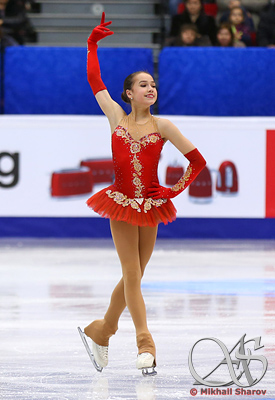 So no hard feelings from my side. In the end this idea waited for a few years and then was implemented in Alina Zagitova's short program.
So no hard feelings from my side. In the end this idea waited for a few years and then was implemented in Alina Zagitova's short program.
We worked with Alina for a few years already, got used to each other, had time to understand, based on her previous years' programs, what serves her better, in which direction we should develop her more. I think after this season ends we will try something new. We want to develop all our skaters, want them to try various choreographies and styles and in the post-Olympic season you have time for experiments.
This season, many skaters kept their programs from the last season or returned to older programs. The fact that Alina kept her long program was also discussed; one opinion was that for younger skaters it might be not the best idea, that younger skaters have to grow up faster and by keeping programs you don't challenge them enough.
The main reason we kept her long program was because it is an Olympic season. Considering the fact that just yesterday she was competing in juniors she had to work on a huge amount of things to be on par with senior ladies. She had to work on her skating, on her style and with all this, not to lose the quality of her jumps. We started with the short program and we spent a lot of time and effort on it. It was rather difficult for her to get into this program - only at Europeans she finally skated it the way I expected her to. It was a big risk to take on two new programs, unsure if we would have been able to be spot on with the long program too. Also, junior competitions are less popular, not many people saw her do this program. We improved that program as much as we could, we added new choreography at the beginning from scratch. Transitions between elements, entrances to and exists from the jumps - just like with all the other programs of all our athletes - we work on them throughout the whole season. If we see that a skater is fed up with something, we try to add new details or just a different glance.  Sometimes it happens that Eteri or I would arrive in the morning and say: "You know, I dreamt about this last night..." or "I was at home, drinking my tea and thinking - what if we do this and that?" So every program is constantly updated.
Sometimes it happens that Eteri or I would arrive in the morning and say: "You know, I dreamt about this last night..." or "I was at home, drinking my tea and thinking - what if we do this and that?" So every program is constantly updated.
What we saw now, at Europeans, is what we will see at the Olympic Games, right? It's too late to make more changes.
Well, for example, one or two days before the competition we changed in Alina's long program an exit from one of her jumps, from her last double Axel before the combo spin. Or yesterday, during the morning practice, we changed the entrance to the double Axel in Zhenia's program. We thought this would be better, and then [during the competition] she did it that way. So this process never stops. If we find a better way to do something, then we need to do it - no reason to wait.
You said in one of your interviews that for every skater you work with you try to find his/her own "trick", speciality. If we take more known skaters from your group, both juniors and seniors, could you describe to me in a few words the "tricks" you found for each one of them? It might be not an easy task, but try.
Actually it's not that difficult to explain. For example, we have skaters who know how to work with their face, with eye contact; they have connection with the audience, with judges.
Like Zhenia, for example?
Like Zhenia, like Alena Kostornaia, like Anna Shcherbakova. In this case you can build your choreography on this communication, create a dialogue.
 Or if we take Alexandra Trusova, for example, in her programs you can emphasise musicality and vigour. This season she has two completely different programs. In her short program we wanted to work more on her artistic side, so she needs to be playful, with positive attitude. In her long program to Vivaldi we used more modern choreography; she performs a lot of complicated things: steps, she works with her upper body, with musical nuances.
Or if we take Alexandra Trusova, for example, in her programs you can emphasise musicality and vigour. This season she has two completely different programs. In her short program we wanted to work more on her artistic side, so she needs to be playful, with positive attitude. In her long program to Vivaldi we used more modern choreography; she performs a lot of complicated things: steps, she works with her upper body, with musical nuances.
It always depends on how much time you have and how well you know the skater. When you're invited to work with someone whom you only see at the competitions or don't know at all, you need at least a few training sessions, a few days just to talk to this person, to listen to him or her, to learn what they like. After that you go on the ice, maybe only to try various small things, not for the program yet, just trying different musical pieces and checking what suits, what doesn't, which things have potential to be developed more. And only after that you can start working on choreography.
Apart from skaters from Eteri's group who did you work with this season?
I choreographed Ivan Righini's short program. I worked with junior ice dance couple, Eteri's daughter Diana Davis and her partner Fedor Varlamov. I did both their programs. I also choreographed the short program for the junior pair who got bronze at the Grand Prix Final, Daria Pavliuchenko and Denis Khodykin.
And usually the initiative to work together comes from the skaters, not from you, right?
Right, I don't really see any reason to approach people and "propose" myself, what for? If they want to work with me, they always can contact me.
Still, is there any skater you would have especially loved to work with? If you can just imagine, just theoretically, if you can choose any skater...
 We're not talking about something realistic, right?
We're not talking about something realistic, right?
Well, who knows, maybe this person will read our interview and think: "Hm, an interesting idea!"
..and will think: "Yeah, I should probably switch Orser and Wilson and go to Gleykhengauz for choreography!" (smiles). Of course, I would have loved to work with Yuzuru (Hanyu), with Javier (Fernandez). I would have loved to work with our guys too, for example, with Misha (Kolyada). But he also has a great team - both coach and choreographer, everyone likes their work, his component grades reflect his skating level. But if we're talking in general and for the future, I would have loved to work more with pairs and ice dance couples. I have a lot of ideas - choreography for two people. Certain things are harder to deliver with a single skater. Working with two people takes more time, it's complicated, but interesting. When you have two people to work with it opens many opportunities.
You worked in Ilia Averbukh's company, took part in his shows. Have you ever considered creating a show of your own?
Yes, of course I was thinking about it. When I worked with Ilia, I was watching how they worked, it was very interesting, I loved that. Even now sometimes when I work on a program I might say something like: "If only we could have a light coming from here or add some theatrical smoke there... If only we could use at this moment this prop, everyone for sure would have cried." So of course, I would love to try. But everything should go step by step. It's still a bit too early, I think maybe later, maybe after the next Olympics or maybe after two Olympic cycles, I will try staging bigger shows, more grand-scale projects.

What does your regular day look like?
I wake up, have breakfast, drive to the rink, coach, drive back home, have a dinner, check on the internet some things related to figure skating, or choreography, or music, chat with my friends, go to bed. (smiles)
The "coach" part is what interests me the most. How is your group divided between the coaches? Do you have any particular tasks and responsibilities? Do you work with your skaters off ice?
Of course, we have off ice work too. We have warm ups, choreography classes, jazz classes. We have two groups - younger skaters and senior skaters, - 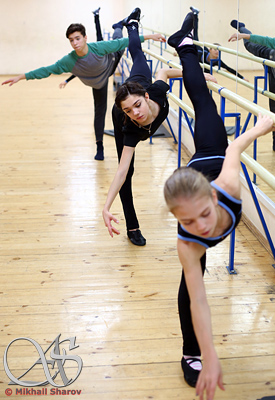 each group has two on-ice sessions, an hour and a half long each, so overall it's six hours.
each group has two on-ice sessions, an hour and a half long each, so overall it's six hours.
When on the ice everyone works with everyone, we don't have individual lessons and all coaches - Eteri, Sergei Viktorovich (Dudakov), and I - we all are responsible for all aspects. Whether it is skating skills and I start working with them, both Eteri and Sergei Viktorovich make comments and remarks, or we work on jumps and also, all three of us will correct mistakes. This way everyone gets enough attention. Of course, if there is some exhibition program we need to work on, I can take this skater for the next session and work with him individually, to choreograph the number or to perfect certain details like step sequences. But in general all the work is divided equally among all three of us.
We also have experts who work with them off ice. My mother, Shalashova Lyudmila Borisovna, works on choreography, Alexei Zheleznyakov teaches jazz. Sergei Viktorovich always comes to all the warm ups.Eteri and I join in sometimes too. So everybody is everywhere watching everything.
One of the most discussed topics in figure skating now is the "arms race" of the technical level of the programs. Men master multiple quads; ladies go for triple Axels and quads, also in your group. How dangerous is this, do you think?
It all depends on the readiness of the athlete. If you make an unprepared person try complicated things lik triple Axels and quads, of course, it will be very dangerous. In our group we have Alexandra Trusova and Anna Shcherbakova who jump quads. But we have others who are not ready yet and we don't start training those jumps with them. Also with these girls it was a very long process, at some point you notice that this certain athlete has enough height in his/her jump, so now it's a matter of faster rotation. First you try it with the jump harness, to make it more safe. Also they have these very thick, padded pants so that it will hurt less when they fall. Also, to avoid injury the number of tries you do during one practice should be limited. You need to make sure that the athlete is still "fresh", not tired, then the risk of injury is lower.
But in general in our sport, unfortunately, you can get injured out of nowhere. Even Anya Shcherbakova who started landing quads got injured during a triple-double-double combination, during the last double loop. 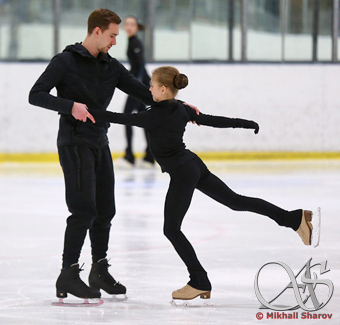 Before the Grand Prix Final Alexey Erokhov successfully landed quad loop and quad flip and during that same practice he fell on his knee while doing a three-turn. He was diagnosed with the sprain, couldn't skate for two weeks and we barely were ready for the Grand Prix Final with his regular jump set up.
Before the Grand Prix Final Alexey Erokhov successfully landed quad loop and quad flip and during that same practice he fell on his knee while doing a three-turn. He was diagnosed with the sprain, couldn't skate for two weeks and we barely were ready for the Grand Prix Final with his regular jump set up.
But do you think it is right? That this is the direction figure skating should develop in?
Yes, you can't stop the progress. The whole process of training has been changed a lot. I remember when I was a skater we did two-three full run-throughs of the program in a week and we thought it was very hard. When we were working on jumps it was something like: you jump once, then after 2-3 minutes you try again. Now the intensity of each training session is much higher, the number of run-throughs they do is much more. For those who from a very young age train like this it is much easier, it's not a problem when you ask them to do a run through, it's not a big deal, they did it already a hundred times. Also, they spend much more time on the ice now; they work a lot on skating skills, at the age of seven they sometimes spend 5-6 hours on the ice, while we did an hour or two.
As a person who competed under a new scoring system and now works in it, in your opinion, what can be changed or improved in it?
This is a very hard question; you can debate over this for hours. Sometimes you think you have a great proposition but then you will get ten arguments why your proposition won't work. For example, I think that the difference, the range between the technical score and the component score can't be very big. It might happen, the difference can be 10-15 points, but if you have a very low technical mark you can't get 20 points more in your components. 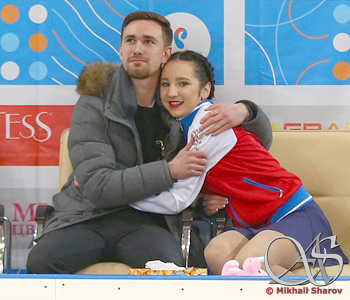 But on the other hand it might hurt more eminent skaters who, for example, have amazing skating skills, very interesting choreography, but they popped jumps or fell, yet still had a decent skate and were able to convey the idea of the program. And if this skater usually has 9 or 10 in his components, but didn't skate well, should he get 7-8 now? It's also not very logical. Still if you had many failures in your program I think you can't get very high components. It's very rare that in such cases the performance full of mistakes will look good. There is also always a human factor. If a girl skates after Carolina Kostner she probably will never get the maximum component score that she deserves because compared to Carolina she will look less good. At the same time if this girl skates after someone unknown she will make a better impression and her component score will be higher.
But on the other hand it might hurt more eminent skaters who, for example, have amazing skating skills, very interesting choreography, but they popped jumps or fell, yet still had a decent skate and were able to convey the idea of the program. And if this skater usually has 9 or 10 in his components, but didn't skate well, should he get 7-8 now? It's also not very logical. Still if you had many failures in your program I think you can't get very high components. It's very rare that in such cases the performance full of mistakes will look good. There is also always a human factor. If a girl skates after Carolina Kostner she probably will never get the maximum component score that she deserves because compared to Carolina she will look less good. At the same time if this girl skates after someone unknown she will make a better impression and her component score will be higher.
In one of your interviews you mentioned how much your mom worked with you on choreography, on "the feeling of the movement." You're working in the same team now. I wonder how much you involve her in your work as a choreographer. Do you seek her advice, do you show her your work?
Of course, I show her my work, even when it's still in the process. She spent a lot of time working on Zhenia's programs, on Alina's programs especially, because ballet is her speciality. They still work a lot on Alina's arms and hand positions both in "Don Quixote" and in "Black Swan". I always highly respect her opinion. If I show something and she says: "It doesn't look good" or "This part is really good, but here better to consider something else", I will for sure listen to it and will try to fix it.  The same thing with Eteri. Working with her I know that nobody will see my choreography when it's not in its best state, she will always check it first and if something is not right, she will add something, propose various solutions and this will make the program shine even more, so I can be sure the final result is always very good.
The same thing with Eteri. Working with her I know that nobody will see my choreography when it's not in its best state, she will always check it first and if something is not right, she will add something, propose various solutions and this will make the program shine even more, so I can be sure the final result is always very good.
I read somewhere that you already choreographed more than 200 programs, meaning around 50 programs in one season!
If you take exhibition programs into consideration it's even more...
From this huge amount of programs, do you have any memorable ones? They don't have to be very well known or winning ones, but memorable for you, which have some interesting story about how they were created.
Of course, there were a lot of interesting stories or moments when I had a creative breakthrough or sudden illumination, like this was with Zhenia's "Anna Karenina". There were a lot of funny stories too, like, for example, an exhibition we did with Adian Pitkeev, with the chair, which he skated at Rostelecom Cup 2015. We created it at night, after his free skate. A few days before the competition I suggested this music, just as a possibility: "Maybe, we'll check this option if it's needed." And when we understood it was indeed needed, right after his free skate we went to our rink and for the whole night we were working on this number. It was loads of fun. We obviously were in a hurry and it was a bit hectic, but after his great performance we were in high spirits. Adian himself was very creative and helped me. And it's always easier to work, when your athlete's eyes are shining and when he says: "And here I can try to do this and that!" And then you answer: "Great idea, let's do this, maybe just do it at this specific moment and on this musical accent." 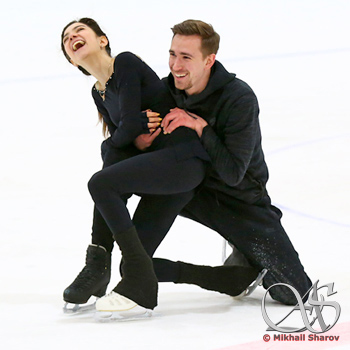 When you work together with the skater, the final result is great and you enjoy the process and the time flies.
When you work together with the skater, the final result is great and you enjoy the process and the time flies.
Or "Sailor Moon" exhibition we did with Zhenia... It was very weird and unclear at first, how you can translate an anime to the ice, nobody did that before, it was something new. And it was amusing how Japanese fans reacted; they were just crazy about it!
You quoted once your father saying that you always need to do your best and then at some point your name will start working for you. Do you feel that after four years of hard work your name is helping you?
I think it's still too early to talk about it. I get recognized more, more people greet me, ask for an interview or for a photo, it feels nice. I didn't have it when I was competing myself. Like every child I was always dreaming of preparing towards the Olympic Games, winning them, but this didn't work out for me. So now, during this Olympic cycle, thanks to Eteri and the whole team, thanks to our wonderful athletes I go through this process, but as a coach. And I enormously enjoy it.
These are going to be your first Olympic Games. Is there any specific moment you're especially looking forward to?
Probably for that moment when your student is performing. This gives you the biggest drive. If you ever experienced that you can't imagine your life without it, your life would be too boring without it, you need that adrenalin. Except now it's different. When you compete, you're responsible for yourself, and for your country, of course. While here you're responsible for other people and this responsibility is much bigger. You understand that if you're nervous or have problems, your main goal is that the person who trusts you - and these are all your athletes - will be certain that you're their rock. Even if they are nervous they should know that their coach is not. They should feel that whatever happens they have a coach who will calm them down or will give them a kick, if that's what's needed, who will find the right words for them to do their best.
